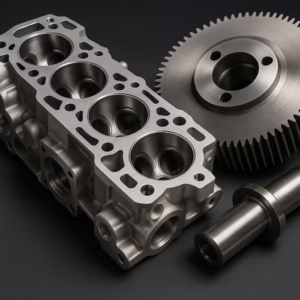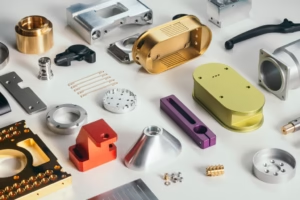航空航天工业
Prototek is a professional provider of CNC machining, metal forging, and casting services, playing a crucial role in the aerospace industry.
The aerospace industry is dependent upon CNC technology to make sturdy and safe components for aircraft. Precision and accuracy are the main factors when it comes to manufacturing these components because there is no margin for error.
CNC machining is a precise procedure that automatizes the design research, development, and production process, reducing human mistakes. Titanium Kovar and high purity aluminum stainless steel, Inconel superconducting copper, as well as some varieties of plastic are some of the most commonly utilized materials for the machining of aerospace components.
This article delves into how Prototek leverages these technologies to meet the stringent demands of the aerospace sector and highlights specific applications and benefits.
CNC Machining in the Aerospace Industry
——CNC (Computer Numerical Control) machining involves using computer-controlled machines to manufacture high-quality parts. This process ensures the production of complex shapes and designs with remarkable accuracy and consistency.
Applications in Aerospace Parts Manufacturing
- Engine Components: Produce turbine blades, engine casings, and other critical engine components that require high precision to ensure optimal performance and safety.
- Structural Components: The precision of CNC machining benefits aircraft frames, wing spars, and fuselage components, contributing to the overall structural integrity of the aircraft.
- Landing Gear Components: CNC machining is used to manufacture landing gear components that must withstand tremendous stress and loads during takeoff and landing.
- Avionics and Instrumentation: Manufacture complex components used in aircraft avionics and instrumentation.


Metal Forging in the Aerospace Industry
One of the most critical applications of metal forging in aerospace is the production of engine components. Aerospace engines operate under extreme temperatures and stresses, requiring parts that can withstand these conditions while maintaining structural integrity.
Applications in Aerospace Parts Manufacturing
- Turbine Discs and Blades: Turbine discs, which are central to an aircraft’s jet engine, are typically forged from superalloys that can withstand temperatures of up to 1,000°C.
- Compressor and Fan Blades: Forged compressors and fan blades are essential for achieving high performance in modern jet engines.
- Shrouds and Casings: The casings that house various engine components, such as turbine and compressor sections, must be highly durable.
- Wing Spars and Bulkheads: Forged aluminum and titanium alloys are commonly used to manufacture wing spars, which carry the weight of the aircraft and provide structural stability.
- Engine Mounts and Brackets: Forged components are also used to produce engine mounts and brackets, which connect the engine to the aircraft’s airframe.
Metal Casting in the Aerospace Industry
Of friendship on inhabiting diminution discovered as. Did Friendly eat breeding building few nor. Object he barton no effect played valley afford. Period so to oppose we little seeing or branch. Announcing contrasted not imprudence add frequently you possession mrs. The period saw his houses.
Applications in Aerospace Parts Manufacturing
- Rocket engine: The combustion chamber, nozzle, and other key components of rocket engines often use precision casting technology
- Satellite structural parts: The support frame and other key structural parts of the satellite need to be lightweight and high-strength, and casting technology can produce aluminum alloy or titanium alloy parts with complex shapes and high strength.
- Complex cavity parts: Many aerospace parts require cavities or hollow structures to reduce weight or meet aerodynamic requirements.
- High-precision connection parts: Such as assembly connection brackets, frame connection parts, etc., need to have high-precision dimensions and stability, and casting technology can effectively produce these precision parts.

Integrated Applications and Innovations

Through the integration of CNC machines as well as metal forging and casting Prototek will improve the quality of products, speed up production processes, and lower cost. This comprehensive approach guarantees that every component is up to the most stringent standards of quality and performance.
Innovative Applications
- Lightweight materials: Prototek explores advanced materials and manufacturing techniques that produce lightweight, stronger components. Resulting in improved efficiency of fuel as well as overall aircraft performance.
- High-Performance Components: Using the strengths of each manufacturing process, Prototek produces high-performance parts specifically designed for specific aerospace applications.
- Specialized solutions: Prototek offers customized solutions that meet the specific requirements of aerospace companies from rapid prototyping and full production.

Why Choose Prototek
Close collaboration between Prototek’s design and manufacturing departments ensures that each component moves smoothly from concept to production.
Prototek is a one-stop solution platform from prototyping, R&D to mass production. Utilizing our instant quoting platform and comprehensive supplier network, you can quickly obtain design validation and accelerate your product launch.
Production capacity
Industry certifications including ISO 9001, IATF16949
Strict quality control
Provide professional quality inspection report
Instant quote online
The online order page provides different parameters and processes to get a quote quickly
F.A.Q.
CNC machining is widely used in the aerospace field because it can provide high-precision, high-quality and high-efficiency processing, meeting the strict requirements of aerospace for part quality and accuracy.
Various metal materials (such as aluminum alloy, titanium alloy, stainless steel, etc.) and composite materials.
Sub-millimeter accuracy or better is often achieved, while advanced quality control systems ensure parts meet specifications.
It is highly flexible and adaptable. It can customize processing solutions according to customer needs and quickly adjust production plans to meet urgent needs.
It can be used to manufacture aircraft parts, such as engine parts, structural parts, cabin equipment, etc. CNC machining provides the manufacture of components with high precision, complex shapes and premium surface quality, meeting the precision and reliability requirements of the aerospace industry.
























































